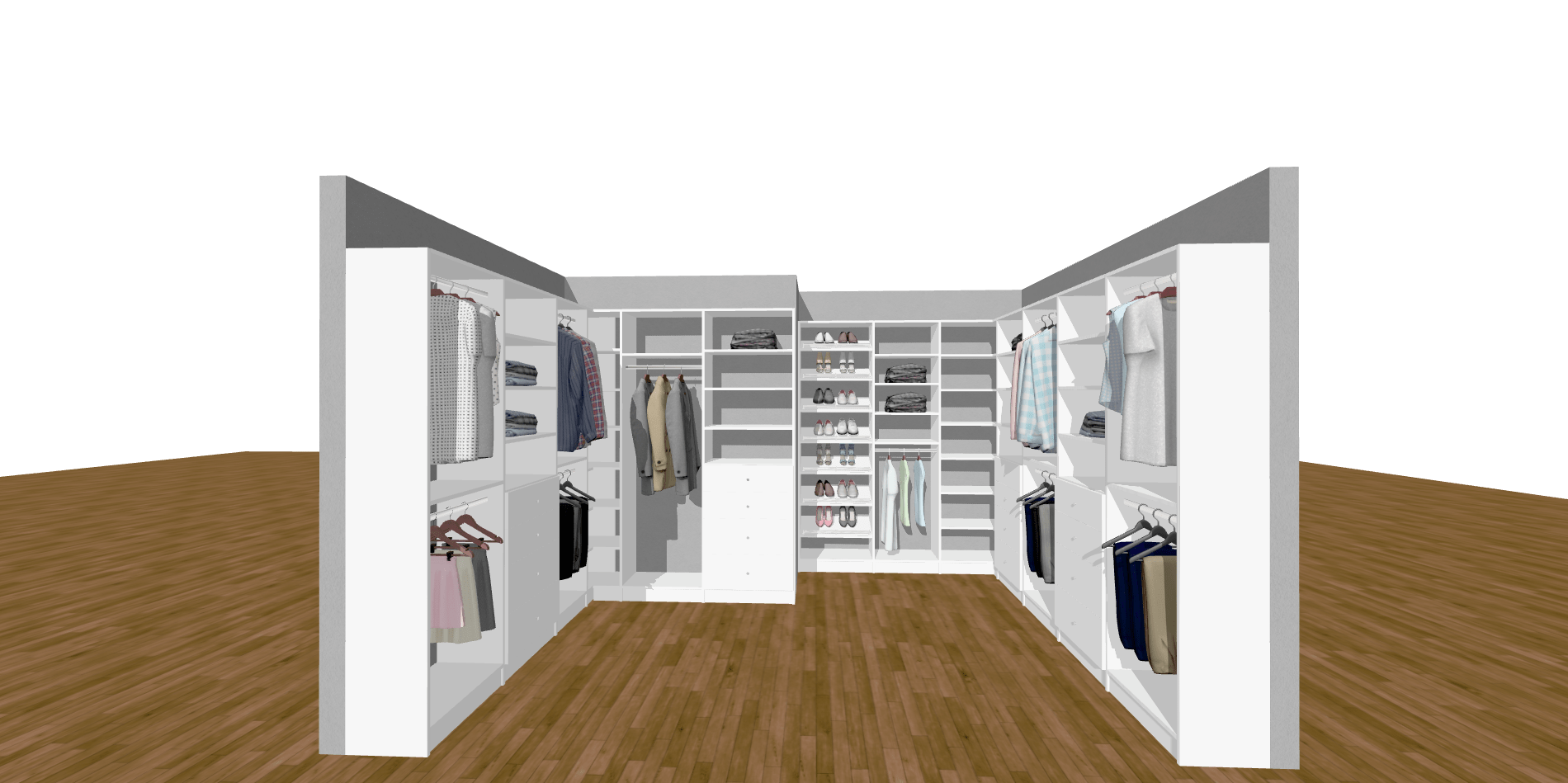Designing a shared closet that works for both partners is all about balance—finding a way to cater to different needs while maintaining a harmonious, functional space. Here are some tips for creating a closet that’s both practical and stylish for “his & hers”:
1. Divide the Space Functionally
- Create Defined Zones: Start by dividing the closet into two main sections—one for each person. You can do this by adding a divider wall or simply by designating space for each person’s items. The idea is to have clear boundaries for clothes, shoes, and accessories.
- Separate Hanging Rods: Install double rods for each person’s clothing. The higher rod can be for long garments like dresses or suits, while the lower rod works for shorter pieces like shirts, pants, or skirts. If space allows, a second rod for each person can help double your hanging capacity.
2. Incorporate Adjustable Shelving
- Customized Shelving: Use adjustable shelving so that you can modify the height based on what each person needs to store. For example, if one person has a lot of shoes while the other has more bags or hats, you can adjust the height of the shelves accordingly.
- Separate Shoe Storage: For shoes, consider creating dedicated areas for each person, such as cubbies or open shelving. A built-in shoe rack or rotating shoe tower can help organize both men’s and women’s footwear in a way that’s easy to access.
3. Use Drawers for Personal Items
- Drawer Organizers: Use drawers for accessories, jewelry, or smaller clothing items like socks and underwear. You can use dividers to keep each person’s items separate, so everything stays organized and easy to find.
- Personalized Drawer Sections: For shared drawers, add dividers or trays to ensure each person has a dedicated space. For example, a drawer for ties, watches, and belts for him, and a drawer for scarves, jewelry, and gloves for her.
4. Maximize Vertical Space
- Higher Shelving: Utilize the top shelf for items that aren’t accessed daily, like seasonal clothes, luggage, or extra bedding. Label bins or storage boxes so you know exactly what’s stored there.
- Hanging Hooks or Pegs: Install hooks or pegs inside the closet door or on the closet walls to store accessories like hats, scarves, or bags. Each person can have their own section of hooks for easy access.
5. Mirror the Closet’s Aesthetic
- Unified Design: Even though you’re creating two separate spaces, make sure the closet feels cohesive. Choose matching finishes for the shelves, rods, and drawers. A neutral color palette or consistent materials, like wood, metal, or glass, can help the two spaces blend seamlessly.
- Shared Elements: Add decorative touches like matching baskets, bins, or rugs that tie the design together. It’s all about finding a balance between function and style.
6. Maximize Drawer Space with Pull-Out Bins
- Pull-Out Bins for Accessories: For smaller items like shoes, scarves, or handbags, use pull-out bins that allow you to access everything easily. These can be labeled for each person’s items, keeping the space tidy while allowing for quick access.
- Customized Tray Dividers: For shared drawer space, use custom tray dividers for things like belts, jewelry, and watches. This prevents items from getting mixed up and keeps everything in its place.
7. Lighting and Mirrors
- Lighting for Both: Install even, adjustable lighting to make the closet functional for both people. LED strip lights or spotlights can illuminate the entire space, ensuring both partners can see everything clearly.
- Full-Length Mirror: A full-length mirror is a must-have in a shared closet. Consider adding one that swings or is mounted to the door to save space but still provides functionality for both partners to check their outfits.
8. Consider Storage for Seasonal Items
- Seasonal Rotations: If you don’t have the space to store off-season clothing year-round, dedicate an area for seasonal rotation. Use labeled bins or vacuum-seal bags for storing clothes when they’re not in season.
- Dual Seasonal Spaces: Have separate seasonal storage for each person, whether it’s a shelf, bin, or under-bed storage. This way, both of you can access and store seasonal items as needed.
9. Personalized Accessories for Each
- Personalized Hooks: Install dedicated hooks or small shelves for personal accessories like bags, hats, or ties. This ensures that each person has their own space for their belongings.
- Jewelry & Watch Storage: Use custom trays, velvet-lined boxes, or drawer dividers for storing jewelry, watches, or small accessories. Having personalized compartments for each person ensures items don’t get mixed up.
10. Incorporate Practical Solutions for Space Constraints
- Vertical Pull-Out Drawers: In tight spaces, use vertical pull-out drawers that maximize every inch. These can be used for shoes, accessories, or even folded clothes.
- Corner Units: Utilize closet corners by adding rotating or pull-out corner shelves, ideal for storing shoes, bags, or less frequently used items.
11. Create a Harmonious Workflow
- Consider Daily Use: Think about how you both access the closet daily. Place the most frequently worn items in easy-to-reach areas (like the middle shelves or rods). Items that are used less often, like special-occasion clothes, can go on higher or lower shelves.
- Height Considerations: Adjust shelving and hanging rods based on your heights to prevent awkward reaching or bending. For example, someone taller may prefer a higher rod, while someone shorter may need lower shelves or rods.
12. Keep Communication Open
- Work Together: Keep the lines of communication open about your needs and preferences when it comes to closet organization. Maybe one person needs more space for shoes while the other has more hanging items—collaborating helps create a more efficient system.
Designing a shared closet with equal functionality for both partners comes down to making the space as customized and accessible as possible. By dividing the space, incorporating shared and personal elements, and maintaining balance, you can create a harmonious and functional closet that works for both of you.

